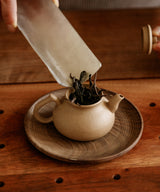Sanyang Peak Shuixian 2017
三仰峰水仙2017
Harvest
April 2017
Origin
Wuyi Mountain, Fujian
The magnificent Wuyi Mountains, a protected Nature’s Reserve in Fujian Province, is home to the some of the most treasured and highly sought after oolongs of China. An UNESCO World Heritage site, it famously consist of 36 peaks, 72 caves and 99 cliffs.
The oolong from Wuyi Mountain is called yancha 岩茶 “cliff or rock oolong”. An extremely rare oolong, the true cliff yanchas are from the limited number of tea trees located within the Nature’s Reserve, and harvested according to ancestral rites on the rocky slopes of the magnificent cliffs.
In the year 1619 during the Ming Dynasty, Xu Biaoran, a native of Wuyi Mountain, compiled and published a book named “Wuyishan Zhilue”. In the four-volume book, he painted an astonishing whole picture of the magnificent Wuyi Mountain. The original painting, called “Wuyi Scenic Spots” is now in the collection of Waseda University in Japan. In the painting, he painted many of the most famous peaks, caves and cliffs, including Shuilian Cave, Matou Cliff, Sanyang Peak, Dawang Peak, Tianxin Cliff, etc.
This special True Cliff yancha is from Sanyang Peak, the highest peak within the Wuyi Mountain Nature Reserve at an elevation of 2400 feet above sea level.
These Shuixian tea trees are around 40 years old – old enough in their varietal to be considered old grove trees. The tea from these trees is crafted by Uncle Huang, a generational tea craftsman with over 4 decades of experience making yancha.
When describing the best yancha, the Chinese use the phrase 岩骨花香, which loosely translates to “cliff bone, floral fragrance,” meaning that the yancha has cliff and mineral notes as its skeleton, combined with a notable floral perfume.
This yancha strikes exactly this arrangement of rock and flowers. Its tannins are softened by time, which gives the tea a mouth-coating richness. The liquor moves gently downwards, across the palate, and its taste extends for a long time. In this downward motion, one can taste so many different inflections of cliff and stone – and with this erosion, comes the distinct bouquet of flowers.
The tea conjures rare wood and mineral notes, as well as cocoa and tobacco. It has a sweet, lingering aftertaste with notes of apricots and tree sap. The complexity with which it presents itself leaves a lasting impression, and seems to reference the remarkable biodiversity of the place from which it came. It is a powerful tea, however it leaves us calm and quited.
To fully enjoy the experience of this tea, I highly recommend using a high grade porcelain gaiwan for brewing. After each infusion, make sure to smell the inside of the lid of your gaiwan with this simple technique: short and quick puffs of air in and out of your nose. The aroma changes dramatically with each puff of air in and out of your nose: woody, musky, mineral, floral, sweet.
. . .
Brewing guide
The key to brewing this tea is to use boiling water, and quick infusions, starting at 10 seconds.
| Tea | 5 g |
| Temperature |
100°C |
| Water | 120 ml |
| Steep time | 10 - 60 sec |
| No. of infusions | 10 |






















